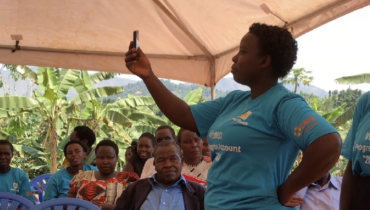Equal Pay Day (#equalpayday) is a symbolic day launched by the National Committee on Pay Equity more than 20 years ago to draw attention to the differences between women and men’s wages. This year, April 10 was selected to represent how long women in the US had work to earn the same amount men earned in 2017.
This means American women had to work over 70 days extra to earn what the average American man earned in one calendar year.
In countries affected by fragility and conflict, Equal Pay Day falls even later.
Pay gap persists in the US
The average American woman still earns approximately 20 percent less than what the average American man earns for doing similar work. This pay gap unfortunately is even more pronounced for most minority women. The gap is largest for Hispanic women, who, on average, are paid only 54 percent of what white men are paid for doing similar work.
The gender pay gap in America has barely changed in the last ten years, and at the current rate of progress, the Institute for Women’s Policy Research estimates the gender wage gap in America won’t close until 2059.
Pay inequity is greater in conflict-affected countries
Earnings inequality and employment discrimination are often intensified in fragile and conflict-affected countries with weakened economic conditions and deeply rooted discriminatory gender norms.
Collecting data is challenging in situations of instability, violence, and typically weak institutional infrastructure. The data that does exist often is not disaggregated by sex. However we can get a sense from data that is reported officially to the International Labour Organisation.
May 2, 2018 is Equal Pay Day for Yemeni women
In 2015 a labor force survey was conducted in Yemen for the first time in 15 years. It revealed that women on average earn 75 cents for every dollar a man earns, making May 2, 2018 Equal Pay Day in Yemen.
While the reported 25 percent wage gap is larger than the 20 percent pay gap in America, it may not be as adverse as expected given Yemen’s political and economic insecurity. Yet the survey also revealed that Yemini women have limited participation in paid employment. Women accounted for a mere 7% of total employment, and only one-third of those women are considered employees- that is people who receive basic remuneration under contractual obligations. The majority of Yemeni women work in the informal economy for family farms and businesses, or are self-employed running small businesses, which can be insecure, and not included in wage gap calculations.
Thus, the wage gap is only representative of a small fraction of Yemen’s population who participate in surveyed employment; it does not capture the scale of gender disparities at work. If those workers were included, “Equal Pay Day” would fall later in the year.
June 5, 2018 is Equal Pay Day for women in Mali
In Mali, the pay gap is even more pronounced for women in formal employment, according to available data. Women have to work an additional half a year (until June 5, 2018) to earn the equivalent of what men earned by the end of 2017. In Mali, only half of working age women are employed, and out of that population, only 10% are formal employees, with the remaining majority of women self-employed or workers on family farms and businesses.
#EqualPayDay is an opportunity to consider the larger repercussions of pay inequality for working women and their families around the world. Women in fragile and conflict-affected countries typically face larger challenges in pursuing economic livelihoods, and often even more daunting pay gaps and employment discrimination.
Combating gender discrimination in pay is only a piece of the puzzle, but it is nonetheless an integral part in advancing towards gender equality.
| Countries | Equal Pay Day * |
| United States of America
(Based on 2016 US Census Data on median earnings for full-time, year-round workers) |
April 10, 2018 |
| Yemen
(Based on 2015 Yemen Labor Force Survey on average monthly earnings) |
May 2, 2018 |
| Mali
(Based on 2016 ILOStat mean nominal earnings of employees by sex and economic activity – Harmonized Series) |
June 5, 2018 |
*To calculate Equal Pay Day in your country: multiply the gender pay gap [ex: 20%] by 365 days. This represents the number of days women work “for free.” Using a 2018 calendar, track when the final free day of labor falls – assuming work occurs M-F without holidays. Because Equal Pay Day historically falls on a Tuesday, select the Tuesday of that week.


